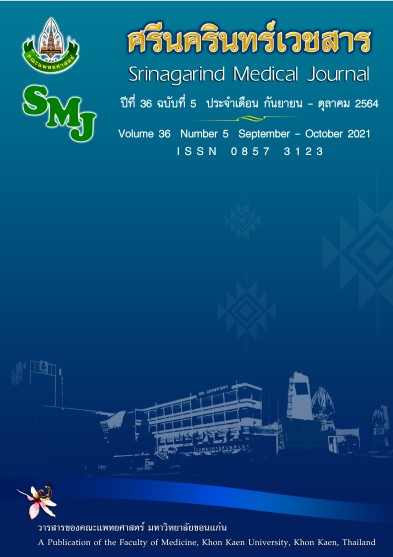Electrocardiographic Survey in Elderly Hypertensive Patients
Keywords:
Elderly; hypertension; electrocardiogramAbstract
Background and objective: The result of electrocardiographic survey in elderly hypertensive patients in Thailand has limited information. This study aimed to investigate the characteristics of electrocardiogram (ECG) in elderly hypertensive patients.
Methods: This research was a survey study. The data was collected during September to October 2018. The population consisted of 165 elderly hypertensive patients treated at Tha Nang Ngam, the primary hospital. The number of sample size was 117 cases calculated from the Taro Yamane formula, the error of 0.05. The instruments in the study were the demographic data form, the basic physical examination form and electrocardiography machine.
Results: Most of elderly hypertensive patients were 75 females (64.1%), mean age 68.8±7.0 years, mean body mass index 25.2±4.5 kg/m2, the average of systolic blood pressure 135.7±14.9 mmHg, the average of diastolic blood pressure 75.8±11.0. The normal ECG was found in 65 elderly hypertensive patients (55.6%). The most abnormal ECG were Left ventricular hypertrophy 13 cases (11.1%) and Inverted T-wave 13 cases (11.1%), Sinus bradycardia 8 cases (6.8%).
Conclusion: The normal ECG was detected in the major group of elderly hypertensive patients. The abnormal ECG were Left ventricular hypertrophy and Inverted T-wave, Sinus bradycardia, respectively.
References
2. Thai hypertension society. 2019 Thai guidelines on the treatment of hypertension [Internet]. 2019. [cited July 19, 2021]. Available from: http://www.thaiheart.org/images/column_1563846428/Thai%20HT%20Guideline%202019.pdf
3. Sinsap N, Jankra J, Jaiman B. Hypertension in elderly: silence killer should be aware. JPNC 2017; 28(1):100-111.
4. Assantachai P, Panchavinnin P, Pisalsarakij D. An electrocardiographic survey of elderly Thai people in the rural community. J Med Assoc Thai 2002; 85(12):1273-1279.
5. Devkota KC, Thapamagar SB, Bista B, Malla S. ECG findings in elderly. Nepal Med Coll J 2006; 8(2):128-132.
6. Ulla M, Debashish KD, Valter S, Bertil S. ECG abnormalities in the elderly: prevalence, time and generation trends and association with mortality. Aging Clin Exp Res 2003;15(6):488-493.
7. Yamane, Taro. Statistics, An Introductory Analysis. 2nd Ed., New York: Harper and Row. 1967.
8. Bangkok hospital. Program to calculate the body mass index. (BMI) [Internet]. 2021. [cited July 19, 2021]. Available from: https://www.bangkokhospital.com/th/center/bariatric-surgery/program-check-bmi
9. Sudipto M, Poonam M, Jyotsnarani P. Study on ECG changes in chronic hypertensive patients in a medical college hospital of Odisha. JMSCR 2016;4(5):10473-10477.
10. Federico G, Lucia M, Luca A, Marco F, Alessandro R, Paolo DF, Riccardo S. The association of left ventricular hypertrophy with metabolic syndrome is dependent on body mass index in hypertensive overweight or obese patients. PLoS ONE 2011;6(1):e16630.
11. Kun Z, Feifei H, Jie C, Qingqing C, Tong W, Rong Z, et al. Independent influence of overweight and obesity on the regression of left ventricular hypertrophy in hypertensive patients a meta-analysis. Medicine 2014;93(25):1-13.
12. Winijkul A, Krittayaphong R. Practical electrocardiography. 1st Ed., Bangkok: October printing Press. 2019.
13. Yamama H, Shamai AG. Sinus Bradycardia [Internet]. 2021, [cited July 19, 2021]. Available from: https://www.ncbi.nlm.nih.gov/books/NBK493201/
14. Vogler J, Breithardt G, Eckardt L. Bradyarrhythmias and Conduction Blocks. Rev Esp Cardiol 2012; 65(7):656-667.




